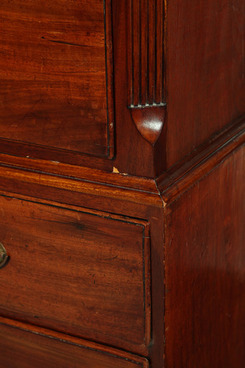 Chamfer is derived from a French word that means exactly what it means in the current usage: a beveled edge. In terms of furniture, a chamfer is a shaped edge where two pieces of wood meet. A chamfered edge refers to what is typically a 45-degree cut on a corner, which results in a softening of the corner. When a corner is softened with a “convex” rounded edge, it’s referred to as a bullnose. Oftentimes in furniture with exterior chamfering on the corners, the cut tapers out at the ends, which is called a variety of things including lamb’s tongue or lark’s tongue. (Some distinguish a lamb’s tongue from a lark’s tongue by using lark’s tongue for a plain, smooth tapered end and lamb’s tongue for tapering that includes a bit of a step and curl at the end.) Exterior chamfers are also sometimes decorated with reeded carving, like the one pictured above. Chamfering on the interior of a piece tends to refer to rough shaping on the panels in doors to taper the panels down to fit the joint. This sort of chamfering also appears on other unseen places including drawer bottoms and case backs. Chamfering, particularly interior chamfering with a hand plane, is one of the most obvious indicators that a piece was handmade instead of mass produced.
Chamfer is derived from a French word that means exactly what it means in the current usage: a beveled edge. In terms of furniture, a chamfer is a shaped edge where two pieces of wood meet. A chamfered edge refers to what is typically a 45-degree cut on a corner, which results in a softening of the corner. When a corner is softened with a “convex” rounded edge, it’s referred to as a bullnose. Oftentimes in furniture with exterior chamfering on the corners, the cut tapers out at the ends, which is called a variety of things including lamb’s tongue or lark’s tongue. (Some distinguish a lamb’s tongue from a lark’s tongue by using lark’s tongue for a plain, smooth tapered end and lamb’s tongue for tapering that includes a bit of a step and curl at the end.) Exterior chamfers are also sometimes decorated with reeded carving, like the one pictured above. Chamfering on the interior of a piece tends to refer to rough shaping on the panels in doors to taper the panels down to fit the joint. This sort of chamfering also appears on other unseen places including drawer bottoms and case backs. Chamfering, particularly interior chamfering with a hand plane, is one of the most obvious indicators that a piece was handmade instead of mass produced.



